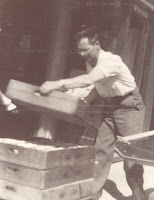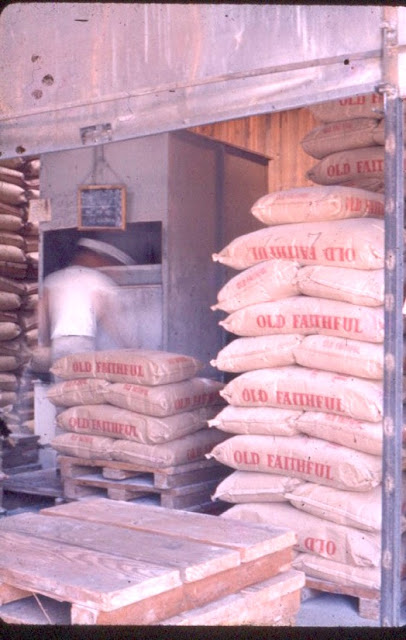The Fluhrer’s Big Loaf Bakery on Fourth and A streets in Eureka, California put me (Stanley Stark) through college and helped me take care of my family. My father Thomas Stark worked at the bakery as a salesman and truck driver for many years before me.
 |
| My father, Tom Stark |
I learned a lot about work from Dick Koenig and Tony Farlan, Arnold Janke, Don Lorensen, and Chris Tamanovich, my bosses over the years. I was only seventeen when I started to work there, but I already had a family and knew I had to work.
It was a day in early May, 1958, when I went down to the bakery and climbed the steps up to the office. They were expecting me. I talked to Mr. Koenig, filled out the paperwork, and he took me over to the little restaurant across “A” street called “The Blue Ox” for something to eat, which he paid for.
 |
| Dick Koenig |
Tony Farlan was there and Mr. Koenig introduced him to me. Tony ordered soup which he pronounced “souwoop.”
One day a few weeks after I started, I took my card from the rack and was about to push it into the time clock, dreading the start of the work day, when I heard a voice in my mind say clearly to me, “Stan, you can like this job as well as hate it!” It was a clear, firm voice, and I knew I should listen to it.
From that moment on I began to like working at the bakery. I left (quit) many, many times and worked other places, but I always loved to go back. In the twenty-four years from when I started until the last day I worked there, I must have left at least 12 times. I never really quit. I was laid off, or I got another job, but I always went back until August of 1982. After that, I became a school district administrator.
Back at the beginning, I had two jobs in April of 1958. I was seventeen, working for Lynn Paxman who was the distributor of the San Francisco Examiner and also for the Humboldt Times. I delivered the Examiner in the morning and rolled papers for the Times at night.
My father, Tom Stark, who I sometimes went to work with when I was a boy, said he talked to Dick Koenig about me working at the bakery. He said to go to the office and fill out the paperwork, and I would be able to work there.
But…. My Father said, “You have to write on the paperwork that you were born in 1940 instead of 1941, because you have to be 18!”
I did what he said.
Dorothy and I were married December 27, 1957 only four
 |
| Dorothy and Me |
and one half months earlier. I was sixteen and she was fifteen. I had been working for the Examiner since I was twelve, and after our marriage I also worked at odd jobs, and finally was hired by the Humboldt times. It hadn’t crossed my mind that my age was a problem getting a job until my father told me.
Dorothy and I both quit high school in December. My mother, Eunice, had signed me up for a correspondence high school course with the American School which was advertised in many magazines.
I began working immediately on the schoolwork and was actually almost done with the rest of high school by May of 1958, the same year.
Tony became my mentor and my financial benefactor. He never gave me money, but he was my contact. Through the next twenty-four years, on and off, I worked at the bakery, and it was Tony I called. If the times were getting financially tight for me and my family, about May, I called Tony.
“Do you need me this summer,” I said, and Tony would always say, “I’ll ask Dick.” A few days later he would call and I, by myself, or with my family would go back from Sacramento to Eureka as soon as school was out.
But back in 1958 at the beginning, the next day after I completed the paperwork, I went to work at eight o’clock in the morning. Since both of my other jobs did not conflict, I kept them. I delivered Examiner papers from about 5:30 a.m. until 7 a.m., and worked at the Humboldt Times from 12 midnight until two or three a.m., and now I worked at the bakery from 8 a.m. until 3:30.
My first duty at the bakery was dumping hamburger buns into the slicer. As soon as the buns went through the slicer they were packed by Eva Minshall and Eunice Purcell into cardboard frames and put into the wrapper. It was a mechanical wrapper that clicked and clacked and made a lot of racket. One of the women put the wrapped buns into wooden bread boxes.
There was a conveyor belt not far from us that was carrying bread wrapped in wax paper out of that room into a room to the east of us. The same as it had been for years, even when I came with my father when I was ten. There were trucks in that room. The conveyor belt went around the corner and down next to the wall where a shipping clerk would load the bread into wooden boxes, and then he stacked the boxes onto the floor next to the trucks.
Though this was my first day of actually working at the bakery for pay, I had been there before, many times with my father.
............These are excerpts from my newest book: FLURHER'S BIG LOAF BAKERY. Order at Lulu.com.











